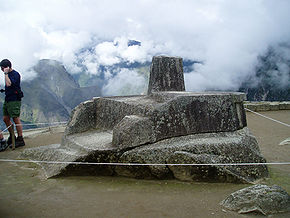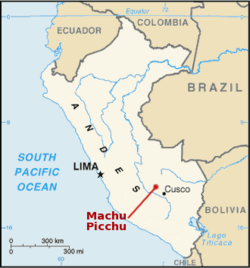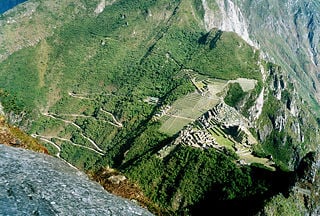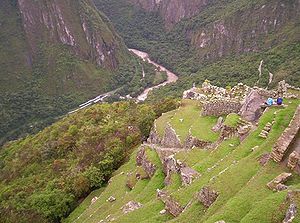Machu Picchu
Machu Picchu (Quechua: Old Mountain; sometimes called the "Lost City of the Incas") is one of the most well known sites of the Incan empire. The ruin is located on the eastern slope of the Andes Mountians, at an elevation of approximately 2450 m (8000 ft). Forgotten for centuries by the outside world, it was brought to international attention by Yale archaeologist Hiram Bingham, who rediscovered it in 1911.
The Rediscovery
On July 24 1911, Hiram Bingham III, an American archaeologist from Yale University, was searching for Vilcabamba, the last stronghold of the Incas during the Spanish conquest of Peru. While exploring the area around Cuzco, the ancient capitol of the Incas, he came across some local farmers and was led to the ruins by their ten year old son. Funded by National Geographic and Yale University, Bingham and his team made several more trips and conducted excavations on the site through 1915, taking thousands of photographs of the ruins and writing a number of books and articles about his findings. Through agreement with the Peruvian government, Bingham borrowed hundreds of artifacts to bring back with him to Yale, agreeing on paper to return them eighteen months later. In 1916, Bingham even writes a letter stating that "they do not belong to us, but to the Peruvian government, who allowed us to take them out of the country on condition that they be returned in 18 months." [1] Despite a seemingly cut and dry breech of the original contract, Yale refused to return the artifacts, citing overlapping civil codes/ statute of limitations, pointing out their excellent preservation of and research on the collection, and claiming that their exhibition of the artifacts generates interest in tourism for Peru.
The collection of archaeological artifacts in the collection of Yale's Peabody Museum was the focus of an intensive reinvestigation by archaeologists Richard Burger and Lucy Salazar, who began looking at the Bingham collection in 1982. Their research has refuted many of the previously held beliefs concerning the purpose and function of the ancient Incan city, and culminated in a travelling exhibit entitled "Machu Picchu: Unveiling the Mystery of the Incas", as well as the 2004 publication of a book of the same name.
History
Archaeologists believe the city was built around 1450 C.E. by the first Imperial Ruler of the Incas, Pachacuti Inca Yupanqui (also called Pachacutec), and was only inhabited for approximately one hundred years, abandoned around the time of the Spanish invasion of Peru in 1532. The intended purpose of the city has been a matter of debate. Initial research done by Bingham's team showed a male to female ratio of more than four to one, leading to the widely held belief that Machu Picchu may have been a training ground for Incan Sun Virgins. More recent examination of the bones by physical anthropologist John Verano has dispelled this idea, showing a more balanced ratio of women to men, as well as the presence of children and the elderly. Archaeological evidence put forth by Burger and Salazar together with research on early colonial documents indicates that Machu Picchu was more likely a country retreat town for Inca nobility.
It is estimated that a maximum of about twelve hundred people resided in Machu Picchu when the royal entourage was in residence, and probably only several hundred lived in the town otherwise. The artisans appear to have been a diverse mix of people from throughout the Inca Empire
The circumstances leading to the abandonment of the site are also somewhat of a mystery. The city was abandoned around the time of the Spanish invasion of Peru, but there are differing opinions on whether or not the Spanish ever set foot in Machu Picchu. The fact that the Intiwatana stone is intact leads some to believe that the Spanish were never at Machu Picchu, as they smashed most similar stones in other Inca cities. Others argue that the lack of valuable gold artifacts, the disoccupation of all the elegant tombs, and evidence of severe fires indicate that the Spanish did, in fact, discover Machu Picchu, although there is no definative evidence either way.[2]
Since 1983 the site has been designated as a UNESCO World Heritage Site.
Location
Machu Picchu is located around 100 kilometers (62.14 miles) to the northwest of Cusco, at an altitude of approximately 2,450 meters (8,000 ft.) above sea level, and actually is located on two peaks: Machu Picchu ("Old Mountain") and Wayna Picchu ("Young Mountain"). Far below is the Urubamba River, surrounding the site on three sides. The climate is temperate and humid, typical for the eastern part of the Andes. It is one of the most important archaeological centers in South America and as a consequence the most visited tourist attraction in Peru. The site was most likely chosen for its beauty, as well as the proximity to a natural spring. The area surrounding the city is filled with many diverse species of flora and fauna. In particular, there are over fifty varieties of orchids. The forests surrounding Machu Picchu have been declared a "sanctuary", and are protected along with the city itself.
Site Layout
Machu Picchu is divided into two main zones: the agricultural sector and the urban sector. The agricultural zone contains more than three hundred terraces, which provided nearly six hectacres of land that made farming possible on the side of a mountain. There are also small dwellings and storehouses present in the agricultural sector.
The urban sector is divided into two main zones: the hanan (upper) sector to the west, which contains the royal palace, the more sacred spaces, and the Intiwatana, and the urin (lower) sector to the east, which contains the Crypt of the Condor, the Palace of the Three Doors, the eastern mausoleum, as well as a great number of dwelling units. The buldings and areas of the urban sector are connected through a series of narrow stairs and paths.
The Inca were experts at a type of stone construction called "ashlar", which dry fit stones so perfectly that not even a knife blade would fit between them. This type of construction was used in areas where the rock would be visable. In other areas, walls were made of more rustic hewn stone and either plastered or stuccoed over. Many dwelling units had two stories, and most likely had thatched roofs. The Inca used a trapezoidal shape for windows and doors, and doors likely were hinged at the top, opening up to be propped up by wood.
The Hanan Sector
The Royal Palace
The royal palace faces the entrance of the royal mausoleum, and is surrounded primarily by gardens and terraces. There are areas thought to house a sentry, and a ring set in the wall that is thought to house a guard animal. The palace has a canal of water and a water supply, as well as areas thought to be residential, hygenic, and a multi purpose hall with many niches in the walls.
The Torreon
The Torreon, also known as the "Temple of the Sun", is the area where Pachakuti is thought to have been mummified and entombed. A semi circular structure of fine ashlar surrounds the crypt, which is carved out of rock. If the crypt did indeed hold the body of the Inca ruler, there would have been a golden statue in his likeness in the Torreon.
The Temple of the Three Windows
The Hanon Sector also houses a temple called the Temple of the Three Windows, named for its distinctive trapezoidal windows. Behind this temple was a large amount of shattered pottery, including many cups and jars, which suggested some sort of ceremony that involved the throwing of vessels. Nearby, the Main Temple of Machu Picchu stands, with its fine polygonal stonework.
The Intiwatana
Behind the Main Temple, a set of stairs leads up to the Intiwatana, or "Hitching Post of the Sun", which can also be accessed from the Main Plaza. The sculpted rock stands 1.8 meters high (6 feet), and rests on a series of carved levels. It is believed that the stone was likely used as a calander, as well as possibly serving an astronomical purpose. Near the stone are three small buildings, which likely served as shelter for guardians of the stone.
The Urin Sector
The Northern Houses and the Palace of the Three Portals
A small cluster of houses to the north of the Urin Sector, as well as the Palace of the Three Portals, may have had some connection to the Royal Palace, due to its location and type of construction.[3]
The purpose of the houses and the Palace of the Three Portals is somewhat unclear, but it is likely that, in addition to other possible purposes, they served as dwellings.
The Mausoleum of the East
Several terraces below, there is a group of eight buildings, mostly subterranean or semi-subterranean, which are believed to have been a mausoleum for important personages.
Architecture and Engineering
All of the construction in Machu Picchu uses the classic Inca architectural style of polished dry-stone walls of regular shape. The Incas were masters of this technique, called ashlar, in which blocks of stone are cut to fit together tightly without mortar. Many junctions are so perfect that not even a knife fits between the stones.
The Incas never used the wheel in any practical manner. How they moved and placed enormous blocks of stones is a mystery, although the general belief is that they used hundreds of men to push the stones up inclined planes. The Incas did not leave any documentation about that process because they did not employ writing.
The space is composed of 140 constructions including temples, sanctuaries, parks and residences.
There are more than one hundred flights of stone steps – often completely carved in a single block of granite – and a great number of water fountains, interconnected by channels and water-drainages perforated in the rock, designed for the original irrigation system. Evidence has been found to suggest that the irrigation system was used to carry water from a holy spring, to each of the houses in turn, the order being dictated by the percieved holiness of the inhabitants. It is suspected that this holy spring was at least a factor in the inca's decision to build the city in such a remote location and could hint at the city's true purpose.[citation needed]
Inca road system
Among the thousands of roads constructed by the pre-Columbian cultures in South America, the roads of the Inca were some of the most interesting. This network of roads converged at Cusco, the capital of the Inca Empire. One of them went to the city of Machu Picchu. The Incas distinguished between coastal roads and mountain roads, the former was called Camino de los llanos (road of the levels) and the latter was called Cápac Ñam.
Today, thousands of tourists walk the Inca roads – particularly The Inca Trail – each year, acclimatising at Cusco before starting on a two to four day journey on foot from the Urubamba valley up through the Andes mountain range.
Simone Waisbard, a long-time researcher of Cusco, claims Enrique Palma, Gabino Sánchez and Agustín Lizárraga left their names engraved on one of the rocks there on July 14 1901, having re-discovered it before Bingham. If this is true, however, no word of their finding ever made it to the outside world; Bingham's work brought Machu Picchu to the world's attention.
Visiting Machu Picchu
In 2003, some 400,000 people visited Machu Picchu, and UNESCO has expressed concern about the damage this volume of tourism is causing to the site. Peruvian authorities insist that there is no problem, and that the remoteness of the site will impose natural limits on tourism [4]. Periodically, proposals are made to install a cable car to the site, but such proposals have so far always been rejected [5].
All visits to Machu Picchu at some point leave from Cusco, which can be reached via a domestic flight from Lima, or international flight from La Paz, in Bolivia. Taking the tourist train from Cusco (which takes 3.5 hours to get to Machu Picchu), you have several options.
The most common way is to take the train to Machu Picchu in the morning, explore the ruins for a few hours and return to Cusco in the afternoon. The train terminates at Puente Ruinas station, where buses take tourists up the mountain to Machu Picchu. Strangely, Machu Picchu station is at Aguas Calientes (2km before Puente Ruinas station) but is not the station used by tourists on a day trip.
Another option is to hike the Inca Trail, on either a four-day or two-day version, both of which are controlled by the government. They require travelers to be reasonably fit. The trip takes a few days, and involves sleeping in tents.
Another option is to stay overnight near the ruins themselves, rather than return on the same day. There are many hotels at nearby Aguas Calientes, or the more expensive Machu Picchu Sanctuary Lodge, the only hotel located at Machu Picchu itself. Buses run from Aguas Calientes to the ruins throughout the day, an 8km ride up the mountain.
A helicopter service from Cusco to Aguas Calientes, via a 24 passenger Russian Mi-8 helicopter, is also available. Helicopter flights direct into Machu Picchu stopped in the 1970s due to concern about their damage to the ruins.
ReferencesISBN links support NWE through referral fees
- ↑ Andrew Mangino (2006-04-12). Elections could avert Peru's lawsuit. Yale Daily News Publishing Company, Inc.. Retrieved June 26, 2006.
- ↑ Luis G. Lumbreras. Machu Picchu. Fundacion Telefonica. Retrieved September 19, 2006.
- ↑ Luis G. Lumbreras. Machu Picchu. Fundacion Telefonica. Retrieved September 26, 2006.
- ↑ Hannah Hennessy (2003-12-27). Row erupts over Peru's tourist treasure. BBC Online. Retrieved June 26, 2006.
- ↑ Malcolm Brabant (1999-08-23). World: Americas Inca site cable car plan sparks anger. BBC Online. Retrieved June 26, 2006.
- This article draws heavily on the corresponding article in the Spanish-language Wikipedia, which was accessed in the version of 8 August 2005. It was translated by the Spanish Translation of the Week collaboration.
Image sources
- This article includes images from PromPerú
External links
- Map of Machu Picchu
- Machu Picchu on Google Maps
- Inca Land; Explorations in the Highlands of Peru by Hiram Bingham, available for free via Project Gutenberg
- Inca Show Pits Yale Against Peru (The NY Times, February 2006. Registration required)
- "Rediscovering Machu Picchu" by Bruce Fellman, Yale Alumni Magazine (December 2002)
- Machu Picchu on the Web (directory)
- Quechua Language and Linguistics an extensive site on the language spoken by the people who built of Machu Picchu.
Guides, descriptions, photos
- Machu Picchu on National Geographic
- Machu Picchu from Geometry Step by Step from the Land of the Incas
- Machu Picchu Guide in spanish
- Machu Picchu and Cusco Guide
- A pictorial guide to Machu Picchu
- 360° panoramic video of Machu Picchu - requires Quicktime
- QuickTime Virtual Tour of Machu Picchu and Peru from destination360.com
Credits
New World Encyclopedia writers and editors rewrote and completed the Wikipedia article in accordance with New World Encyclopedia standards. This article abides by terms of the Creative Commons CC-by-sa 3.0 License (CC-by-sa), which may be used and disseminated with proper attribution. Credit is due under the terms of this license that can reference both the New World Encyclopedia contributors and the selfless volunteer contributors of the Wikimedia Foundation. To cite this article click here for a list of acceptable citing formats.The history of earlier contributions by wikipedians is accessible to researchers here:
The history of this article since it was imported to New World Encyclopedia:
Note: Some restrictions may apply to use of individual images which are separately licensed.





